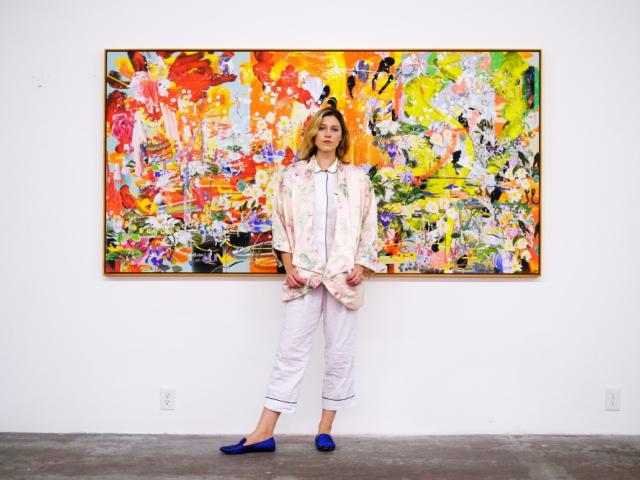An Artist’s Homecoming
Visiting Artists Colloquium series opens with a presentation by Los Angeles-based artists Petra Cortright and Marc Horowitz
By Andrea Estrada for The Current

Artist Petra Cortright’s return to campus this week with her partner and collaborator, Marc Horowitz, to launch the UC Santa Barbara art department’s Spring Visiting Artist Colloquium, is something of a homecoming.
Cortright was only five when her father, Steven Cortright, died in 1991. The UCSB art professor left behind his wife, Penny — an alumna of the department — three young children and a close circle of colleagues and friends from the campus as well as the larger Santa Barbara arts community.
Petra Cortright followed her own artistic calling, completing her master of fine arts degree at the Parsons School of Design in 2008 and quickly becoming an image-making sensation in the contemporary art world. She has since ascended to international prominence.
Originally designed as a forum to invite contemporary artists into conversation with students from the UCSB Department of Art and the College of Creative Studies, the co-sponsored Visiting Artists Colloquium series has since expanded into a course that serves more than 250 students from across campus. Each week, beginning Thursday, April 5, a different artist or arts professional will present for 90 minutes on their practice, followed by a lively, open conversation with the audience. The lectures begin at 5 p.m. in Embarcadero Hall, 935 Embarcadero del Norte in Isla Vista. They are free and open to the public.
“Each colloquium has a different curatorial theme that provides an accessible bridge to the breadth of creative practices by artists,” said Kim Yasuda, an artist and professor of public practice at UCSB and a member of the colloquium’s advisory team. “Last fall, the series focused on socially-engaged artists and this quarter we have a strong representation of studio-based image-makers, with many of these artists living and working in Los Angeles — currently an important center for contemporary art. Many of our graduate students move to L.A. to launch their professional practice, so connecting with artists already in the community is critical to their career development and success.”
Enter Cortright, who lives and works in Los Angeles. Her core practice is the creation and distribution of digital files — videos, GIFs or JPEGs — using consumer or corporate software platforms. She has become renowned for making self-portrait videos that use her computer’s webcam and default effects tools, which she then uploads to YouTube.
Her paintings on aluminum, linen, paper or acrylic are created in Photoshop using painting software and appropriated images, icons and marks. The digital files are endlessly modifiable, but at a “decisive moment” they are translated into two-dimensional objects. They become finite, yet their range of motifs and marks, as well as their disorienting perspectives and dimensions, suggest dynamic change.
Horowitz, Cortright’s partner and collaborator, also is a Los Angeles-based artist, working in painting, performance, video, photography and social practice. Combining traditional drawing, commercial photography and new media, Horowitz explores the idiosyncrasies of entertainment, class, commerce, failure, success and personal meaning. Using visual puns, large-scale participatory projects and viral social pranks, Horowitz creates environments of high energy that lift the most mundane to the status of grand event in complex interplays between subject, viewer and participant.
The Cortright/Horowitz colloquium also inaugurates the department’s pilot for an Artists Project Residency, Yasuda noted. These first artists will participate in a variety of academic and studio activities, including workshops and a studio tour in Los Angeles for the department’s art students. This program invites distinguished and emerging artists for an extended studio-teaching residency that provides opportunities for sustained engagement with students and faculty, while utilizing the well-equipped department maker-labs and rich resources of the university to develop new work.
The colloquium series continues through June 7. Other speakers include:
• April 12 — Alexis Zoto, whose work is inspired by her Albanian Orthodox heritage and deals with themes of acculturation and feminism.
• April 19 — Jeffrey Alan Scudder (JAS), who has taught at UCLA and the Parsons School of Design, has been touring and lecturing internationally on the idea of Radical Digital Painting.
• April 26 — Umer Rashid (Frohawk Two Feathers), whose paintings contain a mashup of historical and cultural references, combining elements of 18th- and 19th-century colonial portraiture and folk art with visual signfiers of contemporary urban culture; and Marsea Goldberg, the founder and director of New Image Art Gallery in Los Angeles.
• May 3 — Rebecca Morris, an abstract painter whose large canvases incorporate drawn elements in a distinctly painterly manner with great sensitivity to facture and tonality.
• May 10 — UCSB master of fine arts graduate student panel featuring Lucy Holtsnider, Robert Huerta, Daria Izad, Jennifer Lugris, Jimmy Miracle, Carolos Ochoa and Toni Scott.
• May 17 — Amir Fallah, whose works across media interrogates systems of portraiture and representation embedded in the history of Western art.
• May 31 — Naida Osline, a Los Angeles-based artist who combines and manipulates images sourced from both analog and digital processes; and Tyler Stallings, a curator and writer in Los Angles who is the newly appointed director of the Frank M. Doyle Arts Pavilion at Orange Coast College.
• June 7 — Ceci Moss, a curator, writer, educator, and founder of Gas, a mobile, autonomous, experimental and networked platform for contemporary art located in a truck gallery parked around Los Angeles and online.
Contact Info:
Andrea Estrada
(805) 893-4620
andrea.estrada@ucsb.edu